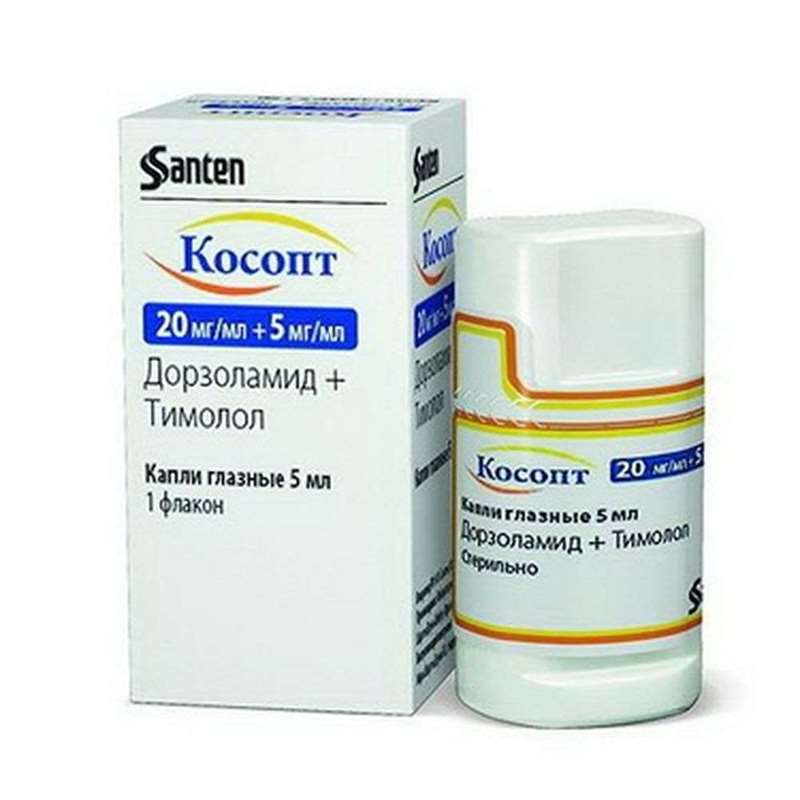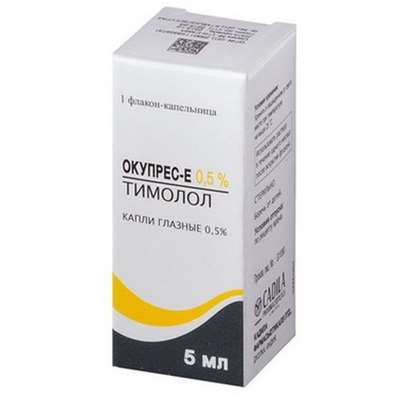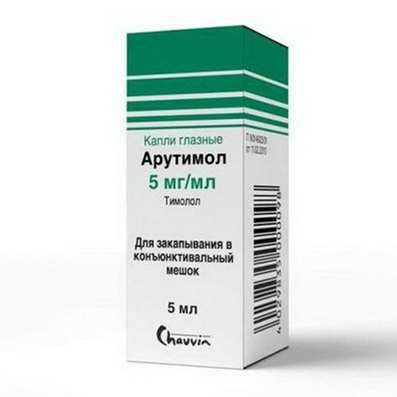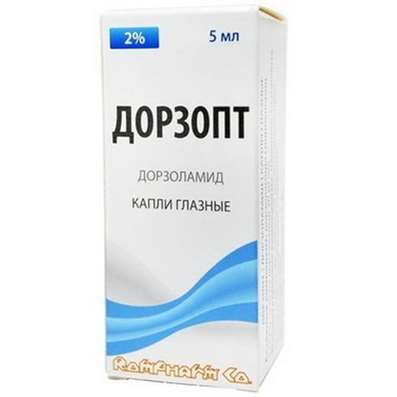Cosopt (Kosopt) eye drops - is a combined preparation that reduces intraocular pressure with open-angle and pseudoexfoliation glaucoma by decreasing the secretion of intraocular fluid. The drug is well tolerated and gives a pronounced effect due to the combination of the two active components.
Cosopt is an antiglaucoma preparation containing two active components: dorzolamide hydrochloride and timolol maleate, each of which reduces the increased intraocular pressure by decreasing the secretion of intraocular fluid. The combined effect of these substances in the composition of the Kosopt combined preparation leads to a more pronounced decrease in intraocular pressure.
Dorzolamide hydrochloride is a selective inhibitor of type II carbonic anhydrase. Inhibition of the carbonic anhydrase of the ciliary body leads to a decrease in the secretion of the aqueous humor, presumably due to a decrease in the formation of bicarbonate ions, which in turn leads to a slowdown in the transport of sodium and liquid.
Timolola maleate is a non-selective beta-blocker. Although the exact mechanism of action of timolol maleate in reducing intraocular pressure has not yet been established, a number of studies have shown a predominant decrease in formation, as well as a slight increase in fluid outflow.
Pharmacokinetics
Dorzolamide hydrochloride
With topical application, dorzolamide penetrates the systemic circulation. With prolonged use, dorzolamide accumulates in erythrocytes as a result of selective binding to carbonic anhydrase of type II, maintaining extremely low concentrations of free drug in plasma. As a result of the metabolism of dorzolamide, a single N-desethyl metabolite is formed, which blocks the carbonic anhydrase of type II less distinctly than its initial form, but at the same time inhibits type I carbonic anhydrase, a less active isoenzyme. The metabolite also accumulates in red blood cells, where it binds mainly to type I carbonic anhydrase.
About 33% of dorzolamide binds to blood plasma proteins. Dorzolamide is excreted in the urine in an unchanged form and in the form of a metabolite. After stopping the use of the drug, dorzolamide is nonlinearly leached from the erythrocytes, which first leads to a rapid decrease in its concentration, and then the elimination slows down. T1 / 2 is about 4 months.
When dorsolamide was taken internally, in order to simulate the maximum systemic exposure during its topical application, a stable state was achieved after 13 weeks. In this case, in fact, no free drug or its metabolites were found in the plasma. Inhibition of erythrocyte carbonic anhydrase was insufficient to achieve a pharmacological effect on renal and respiratory function. Similar pharmacokinetic results were observed with long-term topical administration of dorzolamide hydrochloride. Nevertheless, in some elderly patients with renal insufficiency (creatinine clearance 30-60 ml / min), higher concentrations of metabolite in erythrocytes were detected, but this was not clinically significant.
Timolola maleate
With topical application of timolol, maleate enters the systemic circulation. The concentration of timolol in plasma was studied in 6 patients with topical administration of eye drops of timolol maleate 0.5% twice daily. The mean peak concentration after the morning dosage was 0.46 ng / ml, after daily dosing - 0.35 ng / ml. The hypotensive effect occurs 20 minutes after instillation, reaches a maximum after 2 hours and lasts at least 24 hours.
Indications:
For the treatment of increased intraocular pressure with:
- Open angle glaucoma.
- Pseudoexfoliation glaucoma.
Contraindications:
- Bronchial asthma (including in the anamnesis).
- Severe COPD.
- Sinus bradycardia.
- AV-blockade II and III degree.
- Severe heart failure.
- Cardiogenic shock.
- Renal failure of severe degree (CC (creatinine clearance) is less than 30 ml / min).
- Dystrophic processes in the cornea.
- Pregnancy.
- Lactation (breastfeeding).
- Children and adolescents under 18 years of age (because efficiency and safety have not been adequately studied).
- Hypersensitivity to the components of the drug.
Special instructions:
Application for violations of liver function
There have been no studies of the use of Cosopt in patients with hepatic insufficiency, and therefore the drug in such patients should be used with caution.
Application for violations of kidney function
Contraindication: severe renal insufficiency (CK <30 ml / min).
Use in children
Contraindicated in children and adolescents under 18 years.
Application in elderly patients
49% of patients in clinical trials were 65 years of age or older, and 13% of patients were 75 years of age or older. Differences in efficacy and safety of the drug in these age groups compared with younger patients were not. Nevertheless, the possibility of higher sensitivity to the drug in some elderly patients should not be ruled out.
In Cosopt's clinical studies, 49% of patients were 65 years of age or older, and 13% of patients were 75 years of age or older. Differences in efficacy and safety of the drug in these age groups compared with younger patients were not. Nevertheless, the possibility of higher sensitivity to the drug in some elderly patients should not be ruled out. Like other ophthalmic drugs for topical use, Kosopt can be absorbed into the systemic bloodstream. Timolol included in the drug is a beta-adrenoblocker, thus, adverse reactions known for systemic use of beta-blockers may be noted with topical application of Cosopt, incl. exacerbation of vasospastic angina (prinzmetal angina), peripheral and central circulation disorders, arterial hypotension. Before starting the Cosopt preparation, it is necessary to provide adequate control of heart failure. Patients with a history of severe cardiac disease and signs of heart failure should be closely monitored (it is necessary to monitor the heart rate in such patients). Reports of a lethal outcome as a result of bronchospasm in patients with bronchial asthma and heart failure were registered with the use of eye drops containing timolol maleate. There have been no studies of the use of Cosopt in patients with hepatic insufficiency, and therefore the drug in such patients should be used with caution. The use of systemic inhibitors of carbonic anhydrase can lead to a violation of KSCH and is accompanied by urolithiasis, especially in patients with a history of urolithiasis. During the application of Kosopt, such abnormalities were not observed, reports of urolithiasis were rare. The risk of developing urolithiasis in patients with urolithiasis in an anamnesis can be increased by using Kosopt. it includes an inhibitor of carbonic anhydrase, which, when applied topically, can be absorbed and enter the systemic circulation. Therapy with beta-blockers may distort some of the symptoms of hypoglycemia in patients with diabetes mellitus or hypoglycaemia. Beta-adrenoblockers can smooth the course of hyperthyroidism. Stopping the use of beta-blockers can be the cause of worsening. When the first signs or symptoms of heart failure appear, the use of Kosopt should be discontinued. In the case of an impending surgery with general anesthesia, it is necessary to cancel the drug 48 hours before the surgery, because Timolol enhances the action of muscle relaxants and general anesthetics. Cosopta contains a preservative of benzalkonium chloride, which can cause irritation of the eye. Contact lenses before instillation of the drug should be removed and installed again not earlier than 15 minutes after instillation. Benzalkonium chloride is capable of discoloring soft contact lenses.
When using Cosopt, side effects may develop, which in some patients may make it difficult to drive or work with complex mechanisms.
Suggested Use:
The drug is prescribed 1 drop in the conjunctival sac of the affected eye (or both eyes) 2 times / day.
If Cosopt is appointed as a replacement for another ophthalmic drug for the treatment of glaucoma, the latter should be canceled the day before the application of Cosopt. In case of joint application with other eye drops Kosopt should be prescribed with an interval of at least 10 minutes. Cosopt is a sterile solution, so patients should be instructed how to properly use the bottle.
Instructions for use:
Before using the product for the first time, it must be ensured that the protective strip on the outside of the vial is intact. Unopened vials may have a gap between the vial and the cap.
Remove the protective strip in order to open the cap.
To open the bottle, it is necessary to unscrew the cap by turning it in the direction of the indicator arrows on the upper surface of the cap.
Tilt the head back and slightly pull the lower eyelid downward to create a space between the eyelid and the eye.
Turn the bottle over, use a thumb or forefinger lightly to press in a place specially marked on the bottle so that one drop gets into the eye. Do not touch the surface of the eye or eyelid with the tip of the vial. If used improperly, the vial can become infected and cause serious infection of the eye and subsequent loss of vision.
Repeat paragraphs 4 and 5 for each eye, if the drug should be instilled in both eyes.
Close the bottle with a cap, tightening it until it comes into contact with the bottle. Do not press the cover too much otherwise the bottle or cover may be damaged.
Do not enlarge the opening of a specially designed dispensing tip.
Packaging:
- Comes in original packaging. Item is brand new and unopened.
Storage:
- Keep away from direct sunlight.
- Keep locked and away from children.
- Store in dry place at room temperature.
- Do not exceed storage temperature higher than 25 C
Important notice- the outer box design may vary before prior notice!

 Cart
Cart





